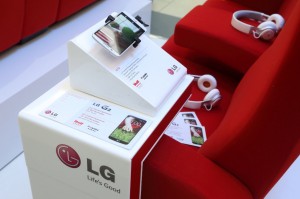 The newest LG CineBeam 4K UHD Laser projector (model HU810P) from LG Electronics is designed to deliver an authentic movie theater experience to consumers in the comfort of their own homes. The latest innovation in LG’s popular high-resolution projector lineup, this projector offers features and technologies that make it the perfect choice for movie lovers and families who are entertaining at home.
The newest LG CineBeam 4K UHD Laser projector (model HU810P) from LG Electronics is designed to deliver an authentic movie theater experience to consumers in the comfort of their own homes. The latest innovation in LG’s popular high-resolution projector lineup, this projector offers features and technologies that make it the perfect choice for movie lovers and families who are entertaining at home.
In addition, to its cinematic quality picture, this model offers easy and convenient access to movies released direct to streaming services via compatibility with popular content streaming apps.
LG CineBeam 4K UHD Laser projector delivers sumptuous, 4K (3,840 x 2,160) resolution up to 300 inches (diagonally) with a dazzling 2,700 ANSI lumens of brightness, offering 97 percent of the DCI-P3 color space with its dual laser system. The projector’s laser light source is extremely reliable and durable, with a lifespan of approximately 20,000 hours of brilliance.
In dedicated theater rooms or typically lit living rooms, the projector delivers vibrant, crystal clear images via LG’s new Brightness Optimizer technology. Iris Mode offers two presets – Bright Room Mode and Dark Room Mode – that detects the amount of light in the room to deliver the best picture possible, even delivering a true movie theater environment if desired. And Adaptive Contrast automatically adjusts each frame to achieve the optimal contrast ratio in darker scenes.
With support for Real Cinema Mode and TruMotion Mode, the new LG CineBeam can show movies as their directors originally intended by adjusting the frame rate of the projected image to match the original source at 24Hz. LG’s TruMotion is especially well-suited for action movies, rendering quick movements and fast scenes smoothly and naturally. The projector supports a variety of popular HDR formats, including HDR10 and HLG, as well as Dynamic Tone Mapping.
For maximum convenience, LG CineBeam 4K UHD Laser projector features wireless connectivity with home theater audio systems via Bluetooth. When connecting via HDMI 2.1 with enhanced audio return channel (eARC), the projector delivers 4K images in 10-bit color with nearly lossless audio quality. Positioning the CineBeam anywhere in the room is a cinch thanks to its 1.6X zoom and horizontal and vertical lens shift.
The projector runs LG’s newest webOS 5.0 platform for intuitive control and navigation as well as quick access to popular streaming services such as Disney+ and YouTube. It is compatible with Apple AirPlay 2 and Screen Share, giving viewers the ability to share content from smartphones and tablets at cinematic scale.
“Our new CineBeam projector performs equally well with bright or dark scenes, elevating picture quality and enhancing the viewing experience to a whole new level,” said Jang Ik-hwan, Senior Vice President and Head of the IT Business Unit of LG Electronics Business Solutions Company.







 Since the mass adoption of the cell phone happened starting in the 1990’s, like everyone else I’ve gone through a long succession of cell phones. My very first cell phone was a Motorola bag phone. Remember those? Analog cell phones could sound surprisingly good. Of course, in fringe reception areas, the sound quality would often become quite crackly and was prone to dropped calls. Those bag phones could output up to three watts of power, so the reception could be decent depending on the area it was operating in.
Since the mass adoption of the cell phone happened starting in the 1990’s, like everyone else I’ve gone through a long succession of cell phones. My very first cell phone was a Motorola bag phone. Remember those? Analog cell phones could sound surprisingly good. Of course, in fringe reception areas, the sound quality would often become quite crackly and was prone to dropped calls. Those bag phones could output up to three watts of power, so the reception could be decent depending on the area it was operating in.




